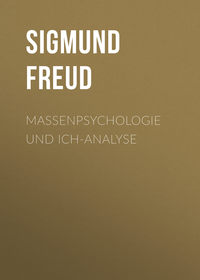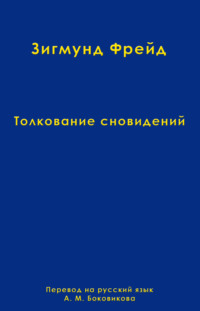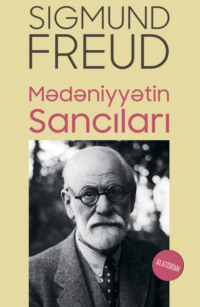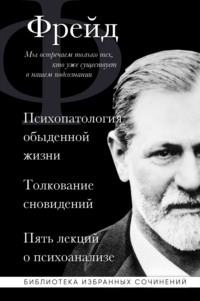 полная версия
полная версияDream Psychology: Psychoanalysis for Beginners
Unless we enter into the part played by the affects in these processes, which can be done here only imperfectly, we cannot continue our discussion. Let us therefore advance the proposition that the reason why the suppression of the unconscious becomes absolutely necessary is because, if the discharge of presentation should be left to itself, it would develop an affect in the Unc. which originally bore the character of pleasure, but which, since the appearance of the repression, bears the character of pain. The aim, as well as the result, of the suppression is to stop the development of this pain. The suppression extends over the unconscious ideation, because the liberation of pain might emanate from the ideation. The foundation is here laid for a very definite assumption concerning the nature of the affective development. It is regarded as a motor or secondary activity, the key to the innervation of which is located in the presentations of the Unc. Through the domination of the Forec. these presentations become, as it were, throttled and inhibited at the exit of the emotion-developing impulses. The danger, which is due to the fact that the Forec. ceases to occupy the energy, therefore consists in the fact that the unconscious excitations liberate such an affect as – in consequence of the repression that has previously taken place – can only be perceived as pain or anxiety.
This danger is released through the full sway of the dream process. The determinations for its realization consist in the fact that repressions have taken place, and that the suppressed emotional wishes shall become sufficiently strong. They thus stand entirely without the psychological realm of the dream structure. Were it not for the fact that our subject is connected through just one factor, namely, the freeing of the Unc. during sleep, with the subject of the development of anxiety, I could dispense with discussion of the anxiety dream, and thus avoid all obscurities connected with it.
As I have often repeated, the theory of the anxiety belongs to the psychology of the neuroses. I would say that the anxiety in the dream is an anxiety problem and not a dream problem. We have nothing further to do with it after having once demonstrated its point of contact with the subject of the dream process. There is only one thing left for me to do. As I have asserted that the neurotic anxiety originates from sexual sources, I can subject anxiety dreams to analysis in order to demonstrate the sexual material in their dream thoughts.
For good reasons I refrain from citing here any of the numerous examples placed at my disposal by neurotic patients, but prefer to give anxiety dreams from young persons.
Personally, I have had no real anxiety dream for decades, but I recall one from my seventh or eighth year which I subjected to interpretation about thirty years later. The dream was very vivid, and showed me my beloved mother, with peculiarly calm sleeping countenance, carried into the room and laid on the bed by two (or three) persons with birds' beaks. I awoke crying and screaming, and disturbed my parents. The very tall figures – draped in a peculiar manner – with beaks, I had taken from the illustrations of Philippson's bible; I believe they represented deities with heads of sparrowhawks from an Egyptian tomb relief. The analysis also introduced the reminiscence of a naughty janitor's boy, who used to play with us children on the meadow in front of the house; I would add that his name was Philip. I feel that I first heard from this boy the vulgar word signifying sexual intercourse, which is replaced among the educated by the Latin "coitus," but to which the dream distinctly alludes by the selection of the birds' heads. I must have suspected the sexual significance of the word from the facial expression of my worldly-wise teacher. My mother's features in the dream were copied from the countenance of my grandfather, whom I had seen a few days before his death snoring in the state of coma. The interpretation of the secondary elaboration in the dream must therefore have been that my mother was dying; the tomb relief, too, agrees with this. In this anxiety I awoke, and could not calm myself until I had awakened my parents. I remember that I suddenly became calm on coming face to face with my mother, as if I needed the assurance that my mother was not dead. But this secondary interpretation of the dream had been effected only under the influence of the developed anxiety. I was not frightened because I dreamed that my mother was dying, but I interpreted the dream in this manner in the foreconscious elaboration because I was already under the domination of the anxiety. The latter, however, could be traced by means of the repression to an obscure obviously sexual desire, which had found its satisfying expression in the visual content of the dream.
A man twenty-seven years old who had been severely ill for a year had had many terrifying dreams between the ages of eleven and thirteen. He thought that a man with an ax was running after him; he wished to run, but felt paralyzed and could not move from the spot. This may be taken as a good example of a very common, and apparently sexually indifferent, anxiety dream. In the analysis the dreamer first thought of a story told him by his uncle, which chronologically was later than the dream, viz. that he was attacked at night by a suspicious-looking individual. This occurrence led him to believe that he himself might have already heard of a similar episode at the time of the dream. In connection with the ax he recalled that during that period of his life he once hurt his hand with an ax while chopping wood. This immediately led to his relations with his younger brother, whom he used to maltreat and knock down. In particular, he recalled an occasion when he struck his brother on the head with his boot until he bled, whereupon his mother remarked: "I fear he will kill him some day." While he was seemingly thinking of the subject of violence, a reminiscence from his ninth year suddenly occurred to him. His parents came home late and went to bed while he was feigning sleep. He soon heard panting and other noises that appeared strange to him, and he could also make out the position of his parents in bed. His further associations showed that he had established an analogy between this relation between his parents and his own relation toward his younger brother. He subsumed what occurred between his parents under the conception "violence and wrestling," and thus reached a sadistic conception of the coitus act, as often happens among children. The fact that he often noticed blood on his mother's bed corroborated his conception.
That the sexual intercourse of adults appears strange to children who observe it, and arouses fear in them, I dare say is a fact of daily experience. I have explained this fear by the fact that sexual excitement is not mastered by their understanding, and is probably also inacceptable to them because their parents are involved in it. For the same son this excitement is converted into fear. At a still earlier period of life sexual emotion directed toward the parent of opposite sex does not meet with repression but finds free expression, as we have seen before.
For the night terrors with hallucinations (pavor nocturnus) frequently found in children, I would unhesitatingly give the same explanation. Here, too, we are certainly dealing with the incomprehensible and rejected sexual feelings, which, if noted, would probably show a temporal periodicity, for an enhancement of the sexual libido may just as well be produced accidentally through emotional impressions as through the spontaneous and gradual processes of development.
I lack the necessary material to sustain these explanations from observation. On the other hand, the pediatrists seem to lack the point of view which alone makes comprehensible the whole series of phenomena, on the somatic as well as on the psychic side. To illustrate by a comical example how one wearing the blinders of medical mythology may miss the understanding of such cases I will relate a case which I found in a thesis on pavor nocturnus by Debacker, 1881. A thirteen-year-old boy of delicate health began to become anxious and dreamy; his sleep became restless, and about once a week it was interrupted by an acute attack of anxiety with hallucinations. The memory of these dreams was invariably very distinct. Thus, he related that the devil shouted at him: "Now we have you, now we have you," and this was followed by an odor of sulphur; the fire burned his skin. This dream aroused him, terror-stricken. He was unable to scream at first; then his voice returned, and he was heard to say distinctly: "No, no, not me; why, I have done nothing," or, "Please don't, I shall never do it again." Occasionally, also, he said: "Albert has not done that." Later he avoided undressing, because, as he said, the fire attacked him only when he was undressed. From amid these evil dreams, which menaced his health, he was sent into the country, where he recovered within a year and a half, but at the age of fifteen he once confessed: "Je n'osais pas l'avouer, mais j'éprouvais continuellement des picotements et des surexcitations aux parties; à la fin, cela m'énervait tant que plusieurs fois, j'ai pensé me jeter par la fenêtre au dortoir."
It is certainly not difficult to suspect: 1, that the boy had practiced masturbation in former years, that he probably denied it, and was threatened with severe punishment for his wrongdoing (his confession: Je ne le ferai plus; his denial: Albert n'a jamais fait ça). 2, That under the pressure of puberty the temptation to self-abuse through the tickling of the genitals was reawakened. 3, That now, however, a struggle of repression arose in him, suppressing the libido and changing it into fear, which subsequently took the form of the punishments with which he was then threatened.
Let us, however, quote the conclusions drawn by our author. This observation shows:
1. That the influence of puberty may produce in a boy of delicate health a condition of extreme weakness, and that it may lead to a very marked cerebral anæmia.
2. This cerebral anæmia produces a transformation of character, demonomaniacal hallucinations, and very violent nocturnal, perhaps also diurnal, states of anxiety.
3. Demonomania and the self-reproaches of the day can be traced to the influences of religious education which the subject underwent as a child.
4. All manifestations disappeared as a result of a lengthy sojourn in the country, bodily exercise, and the return of physical strength after the termination of the period of puberty.
5. A predisposing influence for the origin of the cerebral condition of the boy may be attributed to heredity and to the father's chronic syphilitic state.
The concluding remarks of the author read: "Nous avons fait entrer cette observation dans le cadre des délires apyrétiques d'inanition, car c'est à l'ischémie cérébrale que nous rattachons cet état particulier."
VIII
THE PRIMARY AND SECONDARY PROCESS – REGRESSION
In venturing to attempt to penetrate more deeply into the psychology of the dream processes, I have undertaken a difficult task, to which, indeed, my power of description is hardly equal. To reproduce in description by a succession of words the simultaneousness of so complex a chain of events, and in doing so to appear unbiassed throughout the exposition, goes fairly beyond my powers. I have now to atone for the fact that I have been unable in my description of the dream psychology to follow the historic development of my views. The view-points for my conception of the dream were reached through earlier investigations in the psychology of the neuroses, to which I am not supposed to refer here, but to which I am repeatedly forced to refer, whereas I should prefer to proceed in the opposite direction, and, starting from the dream, to establish a connection with the psychology of the neuroses. I am well aware of all the inconveniences arising for the reader from this difficulty, but I know of no way to avoid them.
As I am dissatisfied with this state of affairs, I am glad to dwell upon another view-point which seems to raise the value of my efforts. As has been shown in the introduction to the first chapter, I found myself confronted with a theme which had been marked by the sharpest contradictions on the part of the authorities. After our elaboration of the dream problems we found room for most of these contradictions. We have been forced, however, to take decided exception to two of the views pronounced, viz. that the dream is a senseless and that it is a somatic process; apart from these cases we have had to accept all the contradictory views in one place or another of the complicated argument, and we have been able to demonstrate that they had discovered something that was correct. That the dream continues the impulses and interests of the waking state has been quite generally confirmed through the discovery of the latent thoughts of the dream. These thoughts concern themselves only with things that seem important and of momentous interest to us. The dream never occupies itself with trifles. But we have also concurred with the contrary view, viz., that the dream gathers up the indifferent remnants from the day, and that not until it has in some measure withdrawn itself from the waking activity can an important event of the day be taken up by the dream. We found this holding true for the dream content, which gives the dream thought its changed expression by means of disfigurement. We have said that from the nature of the association mechanism the dream process more easily takes possession of recent or indifferent material which has not yet been seized by the waking mental activity; and by reason of the censor it transfers the psychic intensity from the important but also disagreeable to the indifferent material. The hypermnesia of the dream and the resort to infantile material have become main supports in our theory. In our theory of the dream we have attributed to the wish originating from the infantile the part of an indispensable motor for the formation of the dream. We naturally could not think of doubting the experimentally demonstrated significance of the objective sensory stimuli during sleep; but we have brought this material into the same relation to the dream-wish as the thought remnants from the waking activity. There was no need of disputing the fact that the dream interprets the objective sensory stimuli after the manner of an illusion; but we have supplied the motive for this interpretation which has been left undecided by the authorities. The interpretation follows in such a manner that the perceived object is rendered harmless as a sleep disturber and becomes available for the wish-fulfillment. Though we do not admit as special sources of the dream the subjective state of excitement of the sensory organs during sleep, which seems to have been demonstrated by Trumbull Ladd, we are nevertheless able to explain this excitement through the regressive revival of active memories behind the dream. A modest part in our conception has also been assigned to the inner organic sensations which are wont to be taken as the cardinal point in the explanation of the dream. These – the sensation of falling, flying, or inhibition – stand as an ever ready material to be used by the dream-work to express the dream thought as often as need arises.
That the dream process is a rapid and momentary one seems to be true for the perception through consciousness of the already prepared dream content; the preceding parts of the dream process probably take a slow, fluctuating course. We have solved the riddle of the superabundant dream content compressed within the briefest moment by explaining that this is due to the appropriation of almost fully formed structures from the psychic life. That the dream is disfigured and distorted by memory we found to be correct, but not troublesome, as this is only the last manifest operation in the work of disfigurement which has been active from the beginning of the dream-work. In the bitter and seemingly irreconcilable controversy as to whether the psychic life sleeps at night or can make the same use of all its capabilities as during the day, we have been able to agree with both sides, though not fully with either. We have found proof that the dream thoughts represent a most complicated intellectual activity, employing almost every means furnished by the psychic apparatus; still it cannot be denied that these dream thoughts have originated during the day, and it is indispensable to assume that there is a sleeping state of the psychic life. Thus, even the theory of partial sleep has come into play; but the characteristics of the sleeping state have been found not in the dilapidation of the psychic connections but in the cessation of the psychic system dominating the day, arising from its desire to sleep. The withdrawal from the outer world retains its significance also for our conception; though not the only factor, it nevertheless helps the regression to make possible the representation of the dream. That we should reject the voluntary guidance of the presentation course is uncontestable; but the psychic life does not thereby become aimless, for we have seen that after the abandonment of the desired end-presentation undesired ones gain the mastery. The loose associative connection in the dream we have not only recognized, but we have placed under its control a far greater territory than could have been supposed; we have, however, found it merely the feigned substitute for another correct and senseful one. To be sure we, too, have called the dream absurd; but we have been able to learn from examples how wise the dream really is when it simulates absurdity. We do not deny any of the functions that have been attributed to the dream. That the dream relieves the mind like a valve, and that, according to Robert's assertion, all kinds of harmful material are rendered harmless through representation in the dream, not only exactly coincides with our theory of the twofold wish-fulfillment in the dream, but, in his own wording, becomes even more comprehensible for us than for Robert himself. The free indulgence of the psychic in the play of its faculties finds expression with us in the non-interference with the dream on the part of the foreconscious activity. The "return to the embryonal state of psychic life in the dream" and the observation of Havelock Ellis, "an archaic world of vast emotions and imperfect thoughts," appear to us as happy anticipations of our deductions to the effect that primitive modes of work suppressed during the day participate in the formation of the dream; and with us, as with Delage, the suppressed material becomes the mainspring of the dreaming.
We have fully recognized the rôle which Scherner ascribes to the dream phantasy, and even his interpretation; but we have been obliged, so to speak, to conduct them to another department in the problem. It is not the dream that produces the phantasy but the unconscious phantasy that takes the greatest part in the formation of the dream thoughts. We are indebted to Scherner for his clew to the source of the dream thoughts, but almost everything that he ascribes to the dream-work is attributable to the activity of the unconscious, which is at work during the day, and which supplies incitements not only for dreams but for neurotic symptoms as well. We have had to separate the dream-work from this activity as being something entirely different and far more restricted. Finally, we have by no means abandoned the relation of the dream to mental disturbances, but, on the contrary, we have given it a more solid foundation on new ground.
Thus held together by the new material of our theory as by a superior unity, we find the most varied and most contradictory conclusions of the authorities fitting into our structure; some of them are differently disposed, only a few of them are entirely rejected. But our own structure is still unfinished. For, disregarding the many obscurities which we have necessarily encountered in our advance into the darkness of psychology, we are now apparently embarrassed by a new contradiction. On the one hand, we have allowed the dream thoughts to proceed from perfectly normal mental operations, while, on the other hand, we have found among the dream thoughts a number of entirely abnormal mental processes which extend likewise to the dream contents. These, consequently, we have repeated in the interpretation of the dream. All that we have termed the "dream-work" seems so remote from the psychic processes recognized by us as correct, that the severest judgments of the authors as to the low psychic activity of dreaming seem to us well founded.
Perhaps only through still further advance can enlightenment and improvement be brought about. I shall pick out one of the constellations leading to the formation of dreams.
We have learned that the dream replaces a number of thoughts derived from daily life which are perfectly formed logically. We cannot therefore doubt that these thoughts originate from our normal mental life. All the qualities which we esteem in our mental operations, and which distinguish these as complicated activities of a high order, we find repeated in the dream thoughts. There is, however, no need of assuming that this mental work is performed during sleep, as this would materially impair the conception of the psychic state of sleep we have hitherto adhered to. These thoughts may just as well have originated from the day, and, unnoticed by our consciousness from their inception, they may have continued to develop until they stood complete at the onset of sleep. If we are to conclude anything from this state of affairs, it will at most prove that the most complex mental operations are possible without the coöperation of consciousness, which we have already learned independently from every psychoanalysis of persons suffering from hysteria or obsessions. These dream thoughts are in themselves surely not incapable of consciousness; if they have not become conscious to us during the day, this may have various reasons. The state of becoming conscious depends on the exercise of a certain psychic function, viz. attention, which seems to be extended only in a definite quantity, and which may have been withdrawn from the stream of thought in Question by other aims. Another way in which such mental streams are kept from consciousness is the following: – Our conscious reflection teaches us that when exercising attention we pursue a definite course. But if that course leads us to an idea which does not hold its own with the critic, we discontinue and cease to apply our attention. Now, apparently, the stream of thought thus started and abandoned may spin on without regaining attention unless it reaches a spot of especially marked intensity which forces the return of attention. An initial rejection, perhaps consciously brought about by the judgment on the ground of incorrectness or unfitness for the actual purpose of the mental act, may therefore account for the fact that a mental process continues until the onset of sleep unnoticed by consciousness.
Let us recapitulate by saying that we call such a stream of thought a foreconscious one, that we believe it to be perfectly correct, and that it may just as well be a more neglected one or an interrupted and suppressed one. Let us also state frankly in what manner we conceive this presentation course. We believe that a certain sum of excitement, which we call occupation energy, is displaced from an end-presentation along the association paths selected by that end-presentation. A "neglected" stream of thought has received no such occupation, and from a "suppressed" or "rejected" one this occupation has been withdrawn; both have thus been left to their own emotions. The end-stream of thought stocked with energy is under certain conditions able to draw to itself the attention of consciousness, through which means it then receives a "surplus of energy." We shall be obliged somewhat later to elucidate our assumption concerning the nature and activity of consciousness.
A train of thought thus incited in the Forec. may either disappear spontaneously or continue. The former issue we conceive as follows: It diffuses its energy through all the association paths emanating from it, and throws the entire chain of ideas into a state of excitement which, after lasting for a while, subsides through the transformation of the excitement requiring an outlet into dormant energy.23 If this first issue is brought about the process has no further significance for the dream formation. But other end-presentations are lurking in our foreconscious that originate from the sources of our unconscious and from the ever active wishes. These may take possession of the excitations in the circle of thought thus left to itself, establish a connection between it and the unconscious wish, and transfer to it the energy inherent in the unconscious wish. Henceforth the neglected or suppressed train of thought is in a position to maintain itself, although this reinforcement does not help it to gain access to consciousness. We may say that the hitherto foreconscious train of thought has been drawn into the unconscious.











